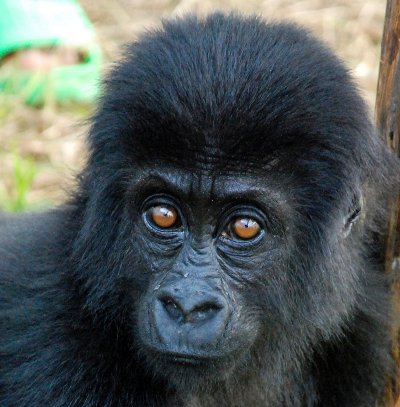Eastern Lowland Gorilla
Category: Gorilla

Facts about Eastern Lowland Gorillas. "Scientific name for Eastern Lowland Gorilla is Gorilla gorilla graueri". The Eastern lowland gorilla has the species name G.b. graueri or Gorilla gorilla graueri, though it is sometimes called the Grauer's gorilla. The Eastern Lowland Gorilla species was first described by Matschie in 1914. The Eastern lowland gorilla is part of the gorilla species, the hominidae family and the order of primates.
The Eastern lowland gorilla and mountain gorilla were put in the eastern gorilla or gorilla beringer group together as the result of a 2001 genetic survey of the species. The mountain gorilla is thus the closest relative to the eastern lowland gorilla, whereas the western lowland gorilla is most closely related to the Cross River gorilla.
The Eastern lowland gorilla weighs around 220 kilograms or 500 pounds (100 to 227 kg). It is also darker than the western lowland gorilla. Eastern gorillas usually have black and dark grown fur, whereas western lowland gorillas have light brown and gray coloring. However, all the lowland gorillas have short, fine fur. The eastern lowland gorillas live in the rain-forests of central Africa, primarily in the Democratic Republic of Congo, Uganda and Rwanda. Eastern lowland gorillas prefer to live in the rain forest over the mountains except for the upland species whose thicker, longer hair makes the colder temperatures more palatable to them. Eastern lowland gorillas live in submontane forests at elevations of 2000 to 9000 feet (609 to 2743 meters). The Eastern Lowland Gorilla species will live in both primary and secondary forests. The mountain subspecies of Eastern lowland gorillas live at elevations of 3000 to 10,000 feet (914 to 3048 meters), enduring two wet and dry seasons each year.
Eastern Lowland Gorillas have a more diverse diet than the western lowland gorilla, and the diet changes with the seasons. The eastern lowland gorilla relies more heavily on fruit in their diet, up to 25% of their overall calories. The Eastern Lowland Gorilla eat leaves and pith for starches. They will eat bamboo if it is available. While overwhelmingly vegetarian, they will sometimes eat ants. Eastern Lowland Gorillas have larger home territories than western gorillas because of their heavier reliance on fruit. They will travel further in a given day, as well, as they exhaust the readily available fruit. They’ll cover up to a mile a day and live in a range of up to two and a half square miles.
Eastern lowland gorillas are endangered. There are less than 5,000 of them in the wild by some estimates, though other sources estimate their numbers to be 15,000. However, even the high number is a tenth of the number of western lowland gorillas. They are doing better than the Cross River and mountain gorillas, who each number in the hundreds.
The Eastern Lowland gorilla is sometimes hunted by the leopard. However, the greatest threat to gorillas is humans. They suffer due to decreased habitat as farming encroaches on the forest and trees are cut down for fuel. The Eastern Lowland Gorilla are sometimes killed for their skins, hands and other items for creation of novelty items and the capturing of baby Eastern Lowland Gorillas as pets or for zoos, though this is less frequent due to various treaties to inhibit wildlife trade. However, the hunting of gorillas for “bush meatâ€, meat from the forest deemed more powerful, healthy and attractive than standard meat like goat meat or beef still occurs. Bush meat is actually a greater problem, since the evidence is readily consumed by customers, destroying the evidence, whereas a stuffed gorilla hand remains an indictment of the animal’s murder for years.

 Back To Category Gorilla
Back To Category Gorilla